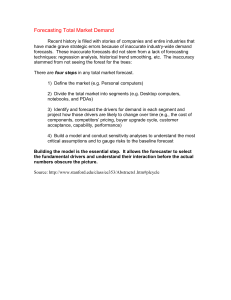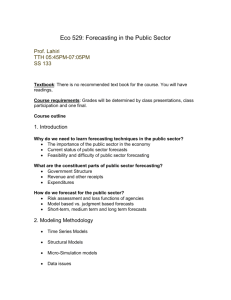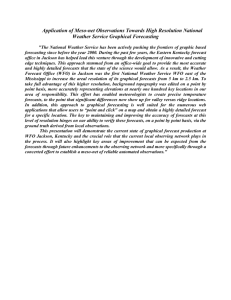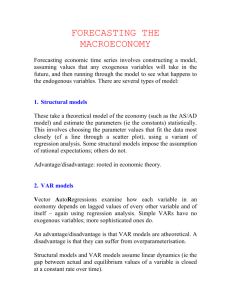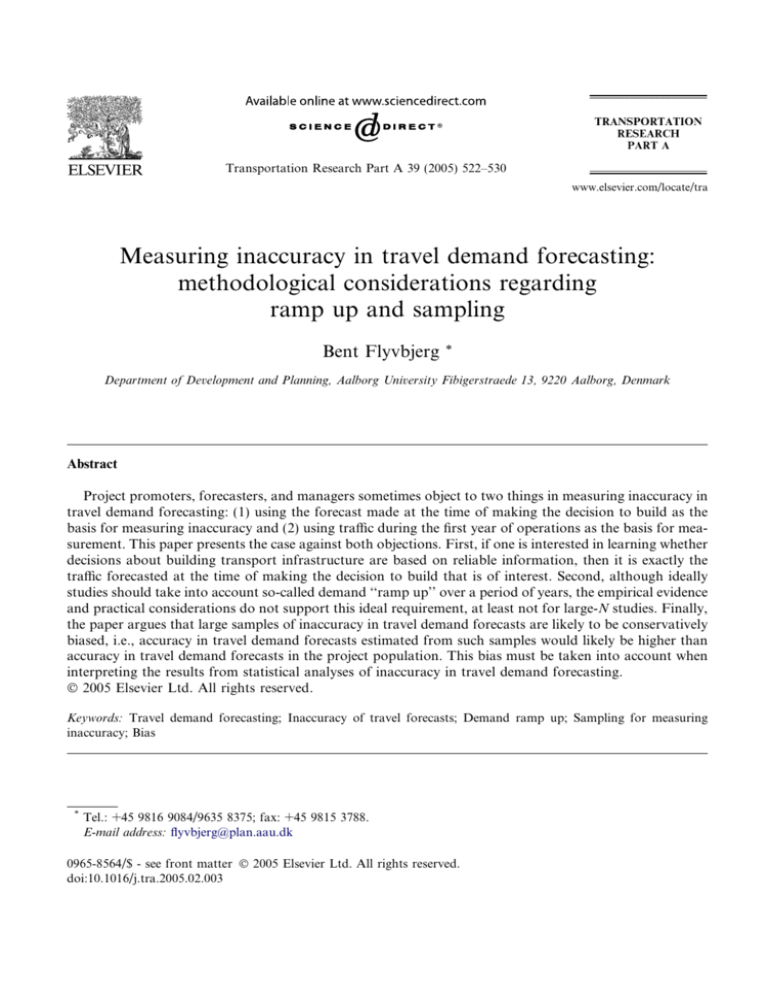
Transportation Research Part A 39 (2005) 522–530
www.elsevier.com/locate/tra
Measuring inaccuracy in travel demand forecasting:
methodological considerations regarding
ramp up and sampling
Bent Flyvbjerg
*
Department of Development and Planning, Aalborg University Fibigerstraede 13, 9220 Aalborg, Denmark
Abstract
Project promoters, forecasters, and managers sometimes object to two things in measuring inaccuracy in
travel demand forecasting: (1) using the forecast made at the time of making the decision to build as the
basis for measuring inaccuracy and (2) using traffic during the first year of operations as the basis for measurement. This paper presents the case against both objections. First, if one is interested in learning whether
decisions about building transport infrastructure are based on reliable information, then it is exactly the
traffic forecasted at the time of making the decision to build that is of interest. Second, although ideally
studies should take into account so-called demand ‘‘ramp up’’ over a period of years, the empirical evidence
and practical considerations do not support this ideal requirement, at least not for large-N studies. Finally,
the paper argues that large samples of inaccuracy in travel demand forecasts are likely to be conservatively
biased, i.e., accuracy in travel demand forecasts estimated from such samples would likely be higher than
accuracy in travel demand forecasts in the project population. This bias must be taken into account when
interpreting the results from statistical analyses of inaccuracy in travel demand forecasting.
Ó 2005 Elsevier Ltd. All rights reserved.
Keywords: Travel demand forecasting; Inaccuracy of travel forecasts; Demand ramp up; Sampling for measuring
inaccuracy; Bias
*
Tel.: +45 9816 9084/9635 8375; fax: +45 9815 3788.
E-mail address: flyvbjerg@plan.aau.dk
0965-8564/$ - see front matter Ó 2005 Elsevier Ltd. All rights reserved.
doi:10.1016/j.tra.2005.02.003
B. Flyvbjerg / Transportation Research Part A 39 (2005) 522–530
523
1. Introduction
As pointed out by Pickrell (1990) and Richmond (1998), estimates of the financial viability of
projects are heavily dependent on the accuracy of travel demand forecasts. Such forecasts are also
the basis for socio-economic and environmental appraisal of transportation infrastructure projects. According to the experiences gained with the accuracy of demand forecasting in the transportation sector, covering traffic volumes, spatial traffic distribution, and distribution between
transportation modes, there is evidence that demand forecasting—like cost forecasting, and despite all scientific progress in modeling—is a major source of uncertainty and risk in the appraisal
of transportation infrastructure projects (Flyvbjerg et al., 2003).
Travel demand forecasts are routinely used to dimension the construction of transportation
infrastructure projects. Here accuracy in forecasts is a point of considerable importance to the
effective allocation of scarce funds. For example, BangkokÕs US$2billion Skytrain was hugely
overdimensioned because the passenger forecast was 2.5 times higher than actual traffic. As a result, station platforms are too long for the shortened trains that now operate the system, a large
number of trains and cars are idly parked in the train garage because there is no need for them,
terminals are too large, etc. The project company has ended up in financial trouble and even
though urban rail is probably a good idea for a congested and air-polluted city like Bangkok,
overinvesting in idle capacity is hardly the best way to use resources, and especially not in a developing nation where capital for investment is scarce. Conversely, a UK National Audit Office study
identified a number of road projects that were underdimensioned because traffic forecasts were
too low. This, too, led to multi-million-dollar inefficiencies, because it is considerably more expensive to add capacity to existing fully used roads than it is to build the capacity up front (National
Audit Office, 1988). For these and other reasons, accuracy in travel demand forecasts matters, as
also pointed out by Hugosson (2005) elsewhere in this issue.
Nevertheless, rigorous studies of accuracy are rare, as are discussion of the methodological
problems involved in measuring accuracy. Flyvbjerg et al. (2005), presents the first statistically
significant study of accuracy in travel demand forecasting, based on analyses of 210 forecasts.
In what follows, the methodological considerations involved in measuring accuracy are
expounded.
2. Defining inaccuracy
In order to estimate the accuracy of travel demand forecasts it is necessary to compare forecasted with actual demand. It is common practice to define the inaccuracy of a demand forecast
as actual minus forecasted demand in percentage of forecasted demand:
I ¼ ððT a T f Þ 100Þ=T f
where I = inaccuracy in percent; Ta = actual travel demand; Tf = forecasted travel demand.
Actual demand is typically counted for the first year of operations (or the opening year). Forecasted demand is typically the estimate for the first year of operations (or the opening year) as
estimated at the time of decision to build the project (the time the project was formally given
the go-ahead).
524
B. Flyvbjerg / Transportation Research Part A 39 (2005) 522–530
Thus the forecast for a given project is the estimate that was available to decision makers when
they made the decision to build the project. By measuring inaccuracy in relation to this base year
one provides an answer to the question of whether the decision to build was an informed one, that
is, whether the decision was based on accurate information, here accurate travel forecasts. If no
estimate of travel demand was available at the time of decision to build, then the closest available
estimate is typically used, often a later estimate resulting in a conservative bias in the measure for
inaccuracy.
With this definition of inaccuracy, perfect accuracy is indicated by zero; an inaccuracy of minus
40%, for example, would indicate that actual traffic were 40% lower than forecasted traffic,
whereas an inaccuracy of plus 40% would mean that actual traffic were 40% higher than forecasted traffic.
Below, the pros and cons of this way of defining and measuring inaccuracy in travel demand
forecasts are discussed.
3. Time of decision to build as base year for measuring inaccuracy
Planners and promoters of transportation infrastructure projects sometimes object to using the
time of decision to build as the base year for measuring inaccuracy (Flyvbjerg et al., 2003). They
say various forecasts are made at different stages of planning and implementation with forecasts
typically becoming more accurate over time. Thus the forecast at the time of making the decision
to build is far from final. It is only to be expected, therefore, that such an early estimate would be
highly inaccurate, and it would be unfair to use this estimate as the basis for assessing the accuracy
of travel demand forecasting, or so the objection goes.
The objection must be rejected, however, because when the focus is on decision making, and
hence on the accuracy of the information available to decision makers, then it is exactly the traffic
forecasted at the time of making the decision to build that is of primary interest. Otherwise it
would be impossible to evaluate whether decisions are informed or not. Forecasts made after
the decision to build are by definition irrelevant to this decision. Whatever the reasons are for
inaccurate forecasts, legislators and citizens—or private investors in the case of privately funded
projects—are entitled to know the uncertainty of forecasted traffic and revenues. Otherwise transparency, accountability, and good governance will suffer.
It is furthermore observed that if the inaccuracy of early traffic estimates were simply a matter
of incomplete information and inherent difficulties in predicting a distant future, as project promoters and forecasters often say it is, then one would expect inaccuracies to be random or close to
random. Inaccuracies, however, have a striking non-random bias just as there are remarkable differences in inaccuracy between modes of transportation, as demonstrated by Flyvbjerg et al.
(2005).
4. The problem with demand ramp up
Planners and promoters also sometimes object to using traffic in the first year of operations (or
in the opening year) as the basis for measuring inaccuracy in forecasts. A manager at Eurotunnel,
B. Flyvbjerg / Transportation Research Part A 39 (2005) 522–530
525
the owner and operator of the Channel tunnel, which is one of the projects my colleagues and I
have studied, put it in the following manner in a comment on some of our previous work: ‘‘[I]t is
misleading to make judgements about success or failure based on traffic revenues in the initial
start-up years of the project’’ (letter from Eurotunnel to the author 1999). If projects experience
start-up problems, which was very much the case for the Chunnel, then this may initially affect
traffic negatively, but it would only be temporarily and it would be misleading to measure inaccuracy of forecasts on that basis, according to this argument. When start-up problems are over,
normal operations will ensue, traffic will increase, and this should be the basis on which inaccuracy is measured, the argument continues. Furthermore, it takes time before travelers effectively
discover and make use of a new transportation facility and change their travel behavior accordingly. Inertia is a factor. A project with lower-than-forecasted traffic during the first year of operations may well catch up with the forecast a few years down the line and it would be more
appropriate to measure inaccuracy on that basis. If the first year of operations is used as the basis
for comparison, the result would be the identification of too many underperforming projects, or
so the opponents to using this basis argue.
At first sight the argument sounds convincing, and in principle (as opposed to in practice) there
is nothing which prevents using another time period than first year of operations as the basis for
measuring inaccuracy. One might, for example, decide to use the fifth year of operations, because
start-up problems might be expected to be ironed out by then; while important external changes in
for instance land use will not have developed fully at this time either.
If demand forecasts do not explicitly model demand for the opening year it is important to be
aware of this. Some forecasts assume so-called demand ‘‘ramp up’’ over the first 3–5 years of a
scheme up to the full modeled demand. For example 50% of total demand in year 1, 80% in year
2, etc. By comparing opening years one may thus be assessing two sources of uncertainty: the inaccuracy of the modeling itself, and the inaccuracy of the assumed ramp up to full demand.
In cost–benefit analyses, errors in the ramps up are likely to have a relatively minor impact on
the total present value of benefits as compared to errors in the forecast total demand. Therefore
the question is whether a focus on the opening year gives too prominent a role to possible rampup errors in comparison to their impact on the overall benefit–cost ratios of projects.
Two measures would solve the issue. One would be to use, e.g., the fifth year to compare forecast to actual demand, as mentioned above. The other would be to do statistical tests as to
whether there is any difference in bias and variability between the opening year and the fifth year
after opening. Such measures are certainly desirable and they may be workable for small-N studies, i.e., studies that cover one or a few projects and where the relevant data have been produced
and stored.
For large-N studies, i.e., studies covering many projects, these ideal measures prove unworkable, however, because in practice only few projects can be found for which a travel demand forecast is available for the fifth year of operations and actual traffic counts are also available for this
year so that inaccuracy may be systematically measured for the year. Available studies with statistical comparisons of the first and the fifth year are even rarer. Many more projects can be found
with available information about forecasted and actual traffic for the first year of operations than
for later years, because it appears to be the most common practice for both forecasters and those
who evaluate the accuracy of forecasts to use first-year-of-operations as the basis for their work
(Fouracre et al., 1990; Pickrell, 1990; National Audit Office, 1992; Walmsley and Pickett, 1992;
526
B. Flyvbjerg / Transportation Research Part A 39 (2005) 522–530
World Bank, 1994). For this reason, in large-N studies it is advisable to stay with first year of
operations as the basis for measuring inaccuracy. Essentially, the state-of-the-art in this specialized area of transportation research is currently such that large-N studies will be impossible if this
advise is ignored. In addition to this line of reasoning the following four arguments support using
the first year of operations as the basis for measuring forecasting inaccuracy.
First, for projects for which data are available on actual and forecasted traffic covering more
than one year after operations begin, it turns out that projects with lower-than-forecasted traffic
during the first year of operations also tend to have lower-than-forecasted traffic in later years.
Thus using first year of operations as the basis for measuring inaccuracy appear not often to result
in the error of identifying projects as underperforming that would not be identified as such if a
different time period were used as the basis for comparison. Actual traffic apparently does not
quickly catch up with forecasted traffic for this type of project, and sometimes it never does.
Ramp up may initially be assumed, but it does not exist in reality for these projects. For instance,
two follow-up studies of the urban rail projects analyzed by Pickrell (1990) showed no significant
gains in patronage over time; for Baltimore, Buffalo, and Pittsburgh patronage actually dropped
over time (Richmond, 1998; Ryan, 2004). For the Channel tunnel, more than five years after
opening to the public, Eurostar train passengers numbered only 45% of that forecasted for the
opening year; rail freight traffic was 40% of that forecasted; the situation has not improved
and the result has been several near-bankruptcies. For the Humber bridge in the UK, 16 years
after opening to the public actual traffic was still only about half of that forecasted. In Denmark,
it took more than 20 years for actual traffic on the New Little Belt bridge to catch up with forecasted traffic, and for several years the difference between forecasted and actual traffic grew larger
instead of smaller. Assuming ramp up for such projects would lead to less accuracy in demand
modeling, not more. These findings fit well with MierzejewskiÕs (1995, pp. 31–32) observation that
the conventional wisdom in forecasting, that in the long run forecasting errors tend to cancel each
other out, is wrong; errors often reinforce each other with the result that inaccuracy becomes
larger when measured against later years as compared to when measured against the first year
of operations. Following this logic, using first year of operations as the basis for measuring inaccuracy would tend to underestimate overall inaccuracy of travel demand forecasts.
Second, sightseeing traffic may be substantial during the first months of operations for the type
of large-scale transportation infrastructure project my colleagues and I have focused on in our
studies, many of which are architectural and engineering marvels, in addition to being prosaic
transportation machines designed to efficiently get people and goods from point A to point B.
Sightseeing traffic is traffic attracted by a project on the basis of peopleÕs desire to see and try
the new transportation facility in question, for instance a new bridge or a new rail line. To illustrate, for the Øresund bridge between Sweden and Denmark, road traffic during the first month of
operations was 19% higher than traffic for the same month one year later. The difference between
the two months can mainly be ascribed to sightseeing traffic, which was somewhat lower than expected by the project company (Trafikministeriet and Sund & Bælt Holding, Ltd., 2002, App. 4:2).
Sightseeing traffic may help offset the possible negative impacts on travel demand from start-up
problems etc. mentioned above, at least for projects that are sufficiently attractive in the publicÕs
eye to warrant sightseeing. The existence of such countervailing influences on traffic during the
start-up phase of projects help explain why first-year-of-operations tend to be a fairly precise basis
for measuring inaccuracy in travel demand forecasts for many projects.
B. Flyvbjerg / Transportation Research Part A 39 (2005) 522–530
527
Third, it may be observed as an empirical fact that forecasters and planners typically use firstyear-of-operations as the principal basis for making their forecasts. For a given project, this is
generally the main forecast presented to decision makers and it forms part of the information
decision makers have at hand in making their decision of whether to build or not. If one wants
to evaluate whether such decisions are informed, then it is the accuracy of this forecast that must
be evaluated and one must therefore compare actual traffic in the first year of operations with
forecasted traffic for that year.
Fourth and finally, if newly opened transport infrastructure projects have a systematic ramp up
period before traffic picks up, as claimed by many planners and promoters, this should be empirically documented and integrated in travel demand modeling. In this way adaption would be
reflected in forecasts instead of being external to these.
In sum, project promoters, forecasters, and managers sometimes object to two things in measuring inaccuracy of travel demand forecasts: (1) using the travel demand forecast made at the
time of making the decision to build as the basis for measuring inaccuracy and (2) using traffic
during the first year of operations as the basis for measurement. However, if one were to follow
the objections then it would be virtually impossible to make meaningful comparisons of forecasted and actual traffic across large numbers of projects and across project types, geographical
areas, and time periods because no common standard of comparison would be available. Finally,
the methodology proposed here as a common standard is already widely used in practice for measuring the inaccuracy of travel demand forecasts. This method conveniently allows meaningful
and consistent comparisons across space and time.
5. Issues of sampling, data collection, and bias
Data that allow the calculation of inaccuracies in travel demand forecasts unfortunately are relatively rare. For public sector projects, often the data are simply not produced. Even where the
intention is to produce the data, projects may develop in ways that make it difficult or impossible
to compare forecasted with actual traffic. For example, forecasted traffic for a given project may
be estimated for the opening year, but due to delays, which are common, the actual opening date
turns out to be several years later than that forecasted, and no forecast of traffic was made for the
actual opening year. In more general terms, methodological differences in how and on what basis
forecasted and actual traffic are estimated often make comparisons difficult or impossible. Finally,
for large projects the elapse of time from forecasts are made, until decision to build, until construction starts, until the project is completed, until operations begin, and until actual traffic
can finally be counted may cover five, ten, or more years. Over such long time periods the assumptions underlying forecasts may be dated and incommensurate when compared to the assumptions
underlying the way actual traffic is measured, or initial plans to compare actual with forecasted
traffic may be given up or simply forgotten.
For private sector projects, traffic typically generates an income for the project owner. Budgeting and accounting is commercial, and therefore travel demand forecasts and traffic counts tend to
be more systematic and more conducive to comparative studies of forecasted and actual traffic
than is the case for public sector projects. This typically does not help scholars much, however,
because traffic data in private projects are often classified to keep them from the hands of
528
B. Flyvbjerg / Transportation Research Part A 39 (2005) 522–530
competitors. And for both public and private projects, data that allow forecasted and actual traffic to be compared may be held back by project owners and managers because the size and direction of differences between forecasted and actual traffic may be of a kind that, if made public,
would make the project look bad in the public eye, for instance where actual traffic is substantially
lower than that forecasted, which is a common situation.
Because of this type of problem with data availability and access, scholarly studies of the accuracy of travel demand forecasts are rare. Where such studies exist, they are characteristically
small-N research, i.e., they are single case studies or they cover only a small sample of projects
(Fouracre et al., 1990; Pickrell, 1990; National Audit Office, 1992; Walmsley and Pickett, 1992;
World Bank, 1994). Consequently, with existing data and studies, it has so far been impossible
to give statistically satisfying answers to questions about how accurate travel demand forecasts
are for transportation infrastructure projects. As a consequence, planners and analysts have
been unable to deliver valid and reliable risk assessments for travel demand, even though such
assessments are a requirement for informed financial appraisal of transportation infrastructure
projects.
As mentioned previously, the study of demand forecasts in 210 transportation infrastructure
projects reported in Flyvbjerg et al. (2005) is the first survey sufficiently large to permit statistically
valid answers to questions regarding the accuracy of travel demand forecasts. To establish a relatively large sample like this, because data are so scarce their availability becomes a main criterion
for data collection. But just because data are available this does not mean they are valid, reliable,
and comparable, as they must be for systematic analysis. To illustrate, the sample of forecasts in
the 210 projects was established on the basis of data from a much larger group of projects, the
majority of which were rejected because of unclear or insufficient data quality. Of 485 projects
considered, 275 were rejected in this manner. Of the 275 rejects, 151 projects were rejected because
inaccuracies for travel demand forecasts in these projects turned out to have been estimated on the
basis of adjusted data for actual traffic instead of using original, real count data, which is more
valid; 124 projects were rejected because inaccuracy had been estimated in ways different from
and incomparable to the way inaccuracy is defined above. In other words, of the 485 observations
only 210 were considered valid, reliable, and comparable. Such quality control of data and rejection of data with low quality is crucial to arriving at useful results when measuring inaccuracy in
travel demand forecasting.
For any sample, a key question is whether it is representative of the population. For a sample
where data availability is crucial to sampling, this question translates into one of whether projects
with available data are likely to be representative. There are four reasons why this question must
be answered in the negative for transportation infrastructure projects with data on the inaccuracy
of demand forecasts.
First, it has been argued that the very existence of data that make the evaluation of performance possible—here performance regarding the accuracy of forecasts—may contribute to improved performance when such data are used by project management to monitor projects
(World Bank, 1994, p. 17). Such projects would have better than average, i.e., non-representative,
performance.
Second, one might speculate that managers and promoters of projects with a particularly bad
track record regarding travel demand forecasts have an interest in not making traffic data available, which would then result in underrepresentation of such projects in the sample. Conversely,
B. Flyvbjerg / Transportation Research Part A 39 (2005) 522–530
529
managers and promoters of projects with a good track record for travel demand forecasts might
be interested in making this public, resulting in overrepresentation of these projects.
Third, even where managers have made traffic data available they may have chosen to give out
data that present their projects in as favorable a light as possible. Often there are several forecasts
of traffic to choose from and several counts or compilations of actual traffic for a given project at
a given time. If researchers collect data by means of survey questionnaires, as is often the case,
there might be a temptation for managers to choose the combination of forecasted and actual traffic that suits them best, possibly a combination that makes their projects look good. An experienced researcher in a large European country, who was giving us feedback on our research for
that country, commented on the data collection (the quote has been anonymized for obvious
reasons):
Most of the [research] is based on [national railway] replies to a questionnaire. This is likely
to create a systematic bias. [The national railways] cannot be trusted to tell you the truth on
these matters. As you know very well, the concept of ÔtruthÕ in these matters is particularly
fragile. The temptation for [the national railways] to take, for the forecasts, the number that
suits them best, this temptation must be great, and I donÕt think they could resist it. What
you would need [in order to obtain better data] would be the original forecast documents,
preferably from the archives of the Ministry of Transportation (not [from the national railways]), that were utilised to take the decision.
Other studies have documented the existence of such ‘‘cooking’’ of data (Wachs, 1989, 1990).
Unfortunately, in practice it proves difficult and often impossible to gain access to the original
forecast documents. This is why researchers sometimes have to rely on the second-best methodology of survey questionnaires. This is also why available data may not be representative data.
Fourth, and finally, differences in the representativity of different subsamples may also result in
non-representative data, for instance differences between rail and road.
The available data do not allow an exact, empirical assessment of the magnitude of the problem
of misrepresentation. It must be concluded, however, for the reasons given above, that given the
current state of the art large samples of forecasted and actual traffic are likely to be biased and the
bias is likely to be conservative. In other words, accuracy in travel demand forecasts estimated
from such samples would likely be higher than accuracy in travel demand forecasts in the project
population. This must be kept in mind when interpreting the results from statistical analyses of
inaccuracy in travel demand forecasting.
References
Flyvbjerg, B., Holm, Mette K.S., Buhl, S.L., 2005. How (in)accurate are demand forecasts in public works projects?
The case of transportation. Journal of the American Planning Association, 71 (2).
Flyvbjerg, B., Bruzelius, N., Rothengatter, W., 2003. Megaprojects and Risk: An Anatomy of Ambition. Cambridge
University Press, Cambridge.
Fouracre, P.R., Allport, R.J., Thomson, J.M., 1990. The performance and impact of rail mass transit in developing
countries. TRRL Research Report 278, Crowthorne: Transportation and Road Research Laboratory.
Hugosson, M.B., 2005. Quantifying uncertainties in a national forecasting model, Transportation Research A, in press,
doi:10.1016/j.tra.2005.02.010.
530
B. Flyvbjerg / Transportation Research Part A 39 (2005) 522–530
Mierzejewski, E.A., 1995. A new strategic urban transportation planning process, University of South Florida, Center
for Urban Transportation Research.
National Audit Office, 1988. Department of Transportation, Scottish Development Department and Welsh Office:
Road planning, London: Her MajestyÕs Stationary Office.
National Audit Office, 1992. Department of Transportation: Contracting for roads, London: National Audit Office.
Pickrell, D.H., 1990. Urban Rail Transit Projects: Forecast versus Actual Ridership and Cost. US Department of
Transportation, Washington, DC.
Richmond, J.E.D., 1998. New Rail Transit Investments: A Review. Harvard University, John F. Kennedy School of
Government, Cambridge, MA.
Ryan, J., 2004. Predicted and actual ridership for recent new starts projects (P04-1165). Presentation at the 83rd Annual
TRB Meeting, Session 501, Washington, DC, January 13.
Trafikministeriet, Finansministeriet, and Sund & Bælt Holding, Ltd., 2002. Udredning af økonomien i A/S
Øresundsforbindelsen (de danske anlæg) (Copenhagen: Author).
Wachs, M., 1989. When planners lie with numbers. Journal of the American Planning Association 55 (4), 476–479.
Wachs, M., 1990. Ethics and advocacy in forecasting for public policy. Business and Professional Ethics Journal 9 (1–
2), 141–157.
Walmsley, D.A., Pickett, M.W., 1992. The cost and patronage of rapid transit systems compared with forecasts.
Research Report 352, Crowthorne: Transportation Research Laboratory.
World Bank, 1994. World development report 1994: Infrastructure for development, Oxford: Oxford University Press.
Bent Flyvbjerg is a professor of planning at Aalborg University, Denmark. He is founding director of the UniversityÕs
research program on large-scale infrastructure projects. He was twice a Visiting Fulbright Scholar to the United States,
where he did research at the University of California at Los Angeles and Berkeley and at Harvard University. His latest
book is Megaprojects and Risk (Cambridge University Press, 2003: with Nils Bruzelius and Werner Rothengatter).

